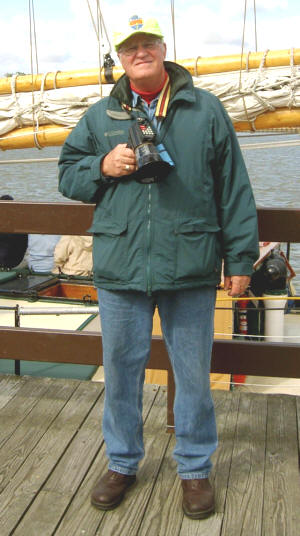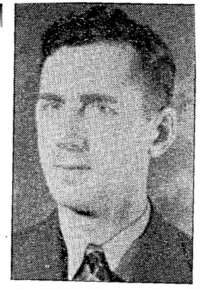What I Learned Last Summer on the Saginaw River: Dynamic Port Potential
|
||||||||||
| Printer Friendly Story View |

Author ready with bullhorn to narrate tour on the schooner Appledore.

Ronald K. MacGillivray as young city planner in 1940.
The Saginaw River offers the greatest economic growth potential for Bay County.
Ronald K. MacGillivray told us that in 1937; today the advice is more pertinent that ever.
This columnist had the opportunity to experience the river last summer and fall in about two dozen trips as tour guide delivering historical interpretation aboard the schooner Appledore and the excursion boats Islander and Princess Wenonah.
Giant ships up to 1,000 feet long carry cargo like coal, stone and salt to docks in Bay City and Saginaw, and the port is the second busiest in Michigan after Detroit.
It's more than exciting to see huge steel bulk freighters like Cuyahoga, Manistee and Sam Laud looming in the river channel. The 62 U.S. flag vessels in the Lake Carriers Association recently were joined by the 730-foot long Edward L. Ryerson, one of two straight-deck bulk carriers on the lakes, put back in service after eight years layup, to handle increasing shipments of iron ore.
Economic developers and public officials looking for dynamic growth potential could take a cue from MacGillivray, who as a graduate student at the University of Michigan in 1937 wrote a report urging a port study and formation of a port commission and development of the port of Bay City.
County Executive Thomas L. Hickner has been talking with maritime business interests in Bay and Saginaw counties about collaboration and has asked State Sen. James A. Barcia to consider a proposal to fund a Saginaw River port study.
River watcher D. J. Story has documented the explosive growth of one lakes shipping operation in the recent issue of Modoc Whistle, newsletter of the Saginaw River Marine Historical Society. Story tells how Capt. Scott Bravener built his company, Lower Lakes Towing, from a small tug and barge in 1994 to 11 vessels and 250 employees. The firm recently was acquired by Rand Logistics Corp. and Capt. Bravener was named to the firm's board.
During a long career as planning engineer with the City of Bay City, MacGillivray was able to oversee development of the riverfront, parks and street system, most of his extensive plan done as a grad student.
The riverfront, dotted with squatters shacks from Depression days and used as a dump, is the most outstanding result of MacGillivray's planning. He never got the new bridge north of Clements Airport from Skull Island to Brooks that he and the state highway department suggested but streets and parks were improved and expanded under his leadership. And he got the industrial area he suggested in the northeast part of the city, Marquette Industrial Park.
An attempt was made at promotion of the port during the early 1960s, in the wake of the euphoria over opening of the St. Lawrence Seaway in 1959.
The effort quickly faded when the large ports like New York and Montreal began containerization, handling shipments in large, easily stacked steel containers.
Foreign ship traffic gradually shrank from a fairly busy trade to what it is today: one foreign ship in the past six years coming to the Saginaw River.
Here's part of the narrative tourists heard aboard the Appledore, Islander and Princess Wenonah:
The river is 22 miles long, drains about 8,600 square miles (about 15 percent of Michigan), and has four main tributaries: the Cass, Tittabawassee, Shiawassee and Flint rivers.
The history of the Saginaw River goes back about two million years; a million years ago four waves of glaciers wiped out the dinosaurs. Man came to this area perhaps 10,000 to 12,000 years ago. Ancient tribes included the Paleo-Indians, Old Copper People, Woodland tribes, Moundbuilders and Sauks. Ancient peoples hunted mammoth, mastodon, caribou, giant hogs and beavers, musk ox, moose and elk. These peoples were the first to work metals, domesticate dogs, trade, make dugout canoes, bury their dead in cemeteries, grow their own food and use tobacco.
Several villages, nine mounds and five burial grounds have been located along the river and bay plus about 15 villages near Kawkawlin.
French explorers Samuel de Champlain and Jean Niccolet visited the area in the early 1600s and learned of the river from the Indians; early French maps reflected information received from the Indians.
Fur merchants John Jacob Astor and Peter Smith began sending traders here in 1809 from their Mackinac Island post. The Trombley family established the first frame house in Bay City, still standing in Veterans Park. Smith's son, Gerrit, was the brother-in-law of pioneer James G. Birney, first anti-slavery Presidential candidate. Both were prominent abolitionists whose activities led to formation of the Republican Party in 1854.
Sailing vessels began calling in the river in 1819 and the first steamboat, Governor Marcy, came in 1836. The trip from Saginaw to Bay City on the steamboat Buena Vista in 1848 took 12 hours.
During the logging boom, 1848-98, the river was continually a mass of long moving logs, according to early business leader Chan Gregory, commenting: "Miles and miles of dockage were covered with the finest lumber to be seen in the world. And great propellers and barges formed an endless scene of activity on our river, carrying our lumber to eastern markets." The Third Street bridge opened for 2,368 vessel passages in the month of July, 1868.
Some 888 ships were built on the river over 190 years from two sloops built at the river mouth by Louis Trombley in 1787 to 600 foot long steel freighters built by Defoe, the last of a dozen Saginaw River shipbuilders, closing the yard in 1977.
The river has the potential to come alive with foreign trade again, fulfilling the promise of the Seaway at last. Lakes shippers are using containerization, promoting the concept of Short Sea Shipping to ease pressure on congested large ports, truck and rail traffic. Seaway traffic is projected to triple in the next 20 years and international trade is estimated to reach two billion tons.
The advice of Ron MacGillivray from 1937 is still pertinent. And, guess what, at 94 years of age, Mr. MacGillivray is still around to consult: he's a part-time engineer with the Bay County Growth Alliance, with offices in the Phoenix Building.###
| Printer Friendly Story View |
|
|

Dave Rogers |
|
|
|
Printer-Friendly Story View
0200 Nd: 04-16-2024 d 4 cpr 0
12/31/2020 P3v3-0200-Ad.cfm
SPONSORED LINKS
12/31/2020 drop ads P3v3-0200-Ad.cfm


